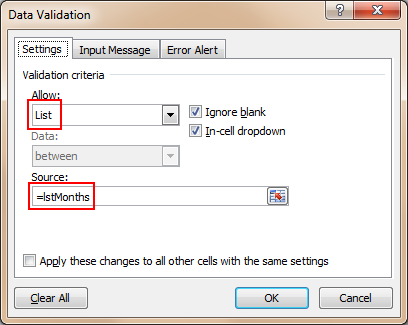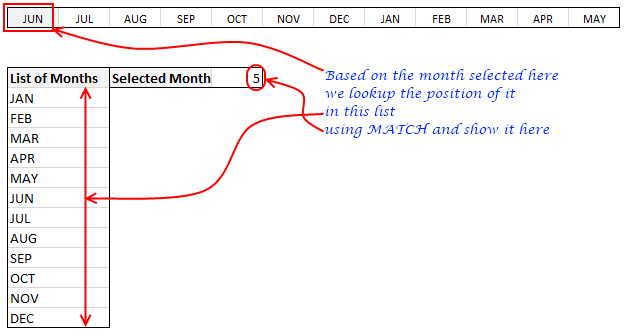Often when we are making spreadsheets for forecasting or planning we would like to keep the starting month dynamic so that rest of the months in the plan can automatically rolled. Don’t understand? See this example:

This type of setup is quite useful as it lets us change the starting month very easily. We can use such a set up in, for eg. Gantt Charts to change the project start dates with ease. Today we are going to learn how to set up automatic rolling months in Excel.
To set up such dynamic rolling months in Excel, just follow these simple steps:
1: Create a list of all the months
Enter the month names in a bunch of cells (Tip: Just enter the first month name and then click at the bottom right corner of that cell and drag to get all the other month names). Let us call this range as B5:B16. If you prefer, name this range as “lstMonths“.
2: Set up data validation drop down list on the first cell for automatic rolling
Now, let us assume we will use cells A1:A12 for automatic rolling months. Select A1 and set up data validation list on it (so that users can only enter a valid month in that cell) and use “List” type as validation. See below:

3: Now write formulas so that we fetch consecutive months based on first month
(Thanks to comments from Jeff, Hui, Vipul and others. I found a simpler and easier way to write the formula)
We will simply use Excel’s date formulas so that we can fetch consecutive rolling months based on the first selection.
Assuming the date is selected in cell A1,
In A2, write the formula:
=DATE(2010,MATCH($A$1,lstMonths,0)+COLUMNS($A$2:A2),1)
What is above formula doing?
- It is using the DATE Formula to create a next months first date.
- The part MATCH($A$1,lstMonths,0) is used to fetch the position of selected month in the range lstMonths
- The part COLUMNS($A$2:A2) is used to generate the sequential numbers in excel.
- Make sure you have formatted the cells A2:A12 as “date” with code “mmm” to show 3 letter month codes.
- Rest all you can figure out easily 🙂
A more complex solution
in-case you got some other types of values instead of months:
To make it a bit simple, I will use a helper cell where we can identify the position of selected month in the list of months, like this:

I have assumed that Jan is 0, Feb is 1 … Dec is 11. Also, assume, the helper cell is in $B$4.
Now, If the selected month is “5”, then the other months will be 6,7,8,9,10,11,0,1,2,3,4.

The interesting part here is the sudden jump from 11 to 0 as highlighted above.
To get this type of output we must use an excel formula called as MOD.
What is Excel MOD Formula?
MOD formula takes 2 numbers tells us the remainder when first number is divided by second number. [Excel MOD formula, Introduction, Syntax & Examples]
So how to use MOD formula to setup rolling months?
Very simple. We just take the value in $B$4 (position of the first month in the list) and then add +1 to it and then find out the MOD of it when divided by 12. We now use this number to fetch the corresponding month from lstMonths.
We use +2 for second month…. +11 for the last month.
We can simplify the +1, +2..+11 part by using COLUMNS formula to generate the sequential numbers for us.
The formula looks like this:
=INDEX(lstMonths,MOD($B$4+COLUMNS($A$2:A2),12)+1)
- The Mod portion of this formula tells the position of the second, third, fourth, … eleventh month based on the first month.
- We have to add +1 to output from MOD because we are using 0,1,2,3 positioning the month in B4, where as INDEX use 1,2,3,4 positioning.
- INDEX formula then fetches the corresponding month from
lstMonths(orB5:B16)
That is all.
Download the example workbook and learn on your own
I have prepared a short example workbook where this technique is demonstrated. Feel free to download it and play with it to learn more.
Where would you use such a rolling month setup?
I have once used the rolling month set up in a forecasting spreadsheet (where we made cash flow projections for a startup we were planning to acquire). I am also planning to upgrade my gantt chart templates include rolling month setup.
What about you? Where would you use automatic rolling months?




















One Response to “How to export YouTube video comments to Excel file? – Free template + Power Query case study”
And I asked myself when i saw your Accouncement Video for the Give away: "Seriously, will Chandoo go manualy thru all his Videos and pick the winners?!". Great connection to the give away with this tutorial 🙂 !